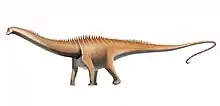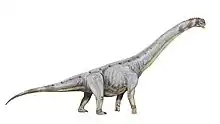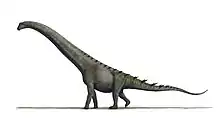Ruyangosaurus
Ruyangosaurus (Ruyang County lizard) is a genus of titanosauriform sauropod dinosaur recovered from the Early Cretaceous Haoling Formation of China. The type species is R. giganteus, described in 2009 by Lü Junchang et al.[1]
| Ruyangosaurus | |
|---|---|
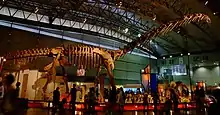 | |
| Skeleton | |
| Scientific classification | |
| Kingdom: | Animalia |
| Phylum: | Chordata |
| Clade: | Dinosauria |
| Clade: | Saurischia |
| Suborder: | †Sauropodomorpha |
| Clade: | †Sauropoda |
| Clade: | †Eusauropoda |
| Clade: | †Neosauropoda |
| Clade: | †Macronaria |
| Clade: | †Titanosauria |
| Genus: | †Ruyangosaurus Lu et al., 2009 |
| Species | |
Description
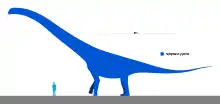
Along with Huanghetitan and Daxiatitan, Ruyangosaurus is among the largest dinosaurs discovered in Cretaceous Asia. In 2016 Gregory S. Paul gave a length of 30 meters (100 ft) and a weight of 50+ tonnes (55 short tons) - making it a 'mega-sauropod'.[2] Ruyangosaurus was probably about 35 meters (115 ft) long, as evidenced by its 207 cm long femur and 127 cm long right tibia.[3] In 2020 Molina-Perez and Larramendi gave a lower estimation of 24.8 meters (81.4 ft) and 34 tonnes (37.5 short tons).[4]
Classification
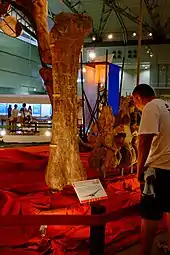

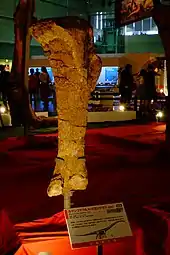
The describers of Ruyangosaurus assigned it to Andesauridae.[1] However, Andesauridae is not monophyletic and, as such, is no longer used.[5]
The most comprehensive phylogenetic dataset to include Ruyangosaurus finds it to be in a polytomy with Andesaurus and other basal titanosaurs and near-titanosaur somphospondyls, supporting the original description's assertion of phylogenetic proximity of it and Andesaurus, though not the precise taxonomic assignment.[6][7]
| Macronaria |
| |||||||||||||||||||||||||||||||||||||||||||||||||||||||||||||||||||||||||||||||||||||||||||||||||||||||||||||||||||||||||||||||||||||||||||||||||||||||||||||||||||||||||||||||||||||||||||||||||||||||||||||||||||||||||||
However, not all phylogenetic analyses have supported its position as a somphospondyl. A smaller phylogenetic dataset found Ruyangosaurus to be a non-titanosauriform macronarian based on additional material from the type locality.[8]
| Macronaria |
| ||||||||||||||||||||||||||||||||||||||||||||||||||||||||||||||||||||||||||||||
Habitat
Ruyangosaurus shared its habitat with Xianshanosaurus, "Huanghetitan" ruyangensis, Yunmenglong, Luoyanggia, and Zhongyuansaurus. The type horizon of Ruyangosaurus was originally described as being of "early Late Cretaceous" age,[1] but recent work has assigned it an Aptian-Albian Age based on fieldwork and analysis of invertebrate and microfossil assemblages.[9]
See also
References
- Lü, J; Xu, L; Jia, S; Zhang, X; Zhang, J; Yang, L; You, H; Ji, Q (2009). "A new gigantic sauropod dinosaur from the Cretaceous of Ruyang, Henan, China". Geological Bulletin of China. 28 (1): 1–10.
- Paul, Gregory S. (2016). The Princeton Field Guide to Dinosaurs 2nd edition. Oxford: Princeton University Press. p. 231. ISBN 9780691167664.
- Jinyou Mo, Jincheng Li, Yunchuan Ling, Eric Buffetaut, Suravech Suteethorn Varavud, Suteethorne Haiyan Tong, Gilles Cuny, Romain Amiot & Xing Xu (2020). New fossil remain of Fusuisaurus zhaoi (Sauropoda: Titanosauriformes) from the Lower Cretaceous of Guangxi, southern China. Cretaceous Research: 104379 (advance online publication). doi: https://doi.org/10.1016/j.cretres.2020.104379
- Molina-Perez and Larramendi (2020). Dinosaur Facts and Figures: The Sauropods and Other Sauropodomorphs. New Jersey: Princeton University Press. p. 261.
- Mannion, Philip D.; Calvo, Jorge O. (2011). "Anatomy of the basal titanosaur (Dinosauria, Sauropoda) Andesaurus delgadoi from the mid-Cretaceous (Albian-early Cenomanian) Río Limay Formation, Neuquén Province, Argentina: implications for titanosaur systematics". Zoological Journal of the Linnean Society. 163: 155–181. doi:10.1111/j.1096-3642.2011.00699.x.
- Mannion, Philip D.; Allain, Ronan; Moine, Olivier (2017). "The earliest known titanosauriform sauropod dinosaur and the evolution of Brachiosauridae". PeerJ. 5: e3217. doi:10.7717/peerj.3217. PMC 5417094. PMID 28480136.
- Royo-Torres, Rafael; Upchurch, Paul; Kirkland, James I.; DeBlieux, Donald D.; Foster, John R.; Cobos, Alberto; Alcalá, Luis (2017). "Descendants of the Jurassic turiasaurs from Iberia found refuge in the Early Cretaceous of western USA". Scientific Reports. 7 (1): 14311. doi:10.1038/s41598-017-14677-2. PMC 5662694. PMID 29085006.
- Lü, Junchang; Pu, Hanyong; Xu, Li; Jia, Songhai; Zhang, Jiming; Shen, Caizhi (2014). Osteology of the giant sauropod dinosaur Ruyangosaurus giganteus Lü et al., 2009. Beijing: Geological Publishing House. ISBN 978-7-116-09074-3.
- Xu, L., Pan, Z.C., Wang, Z.H., Zhang, X.L., Jia, S.H., Lü, J.C., Jiang, B.L., 2012. Discovery and significance of the Cretaceous system in Ruyang Basin, Henan Province. Geological Review 58, 601-613.







